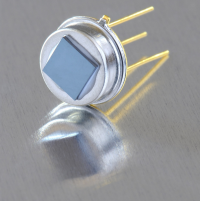 Infrared (IR) Flame Detection
Infrared (IR) Flame Detection
An infrared (IR) flame detection system uses a simple spectroscopic device, a mid IR filter mounted in a broadband Mid IR broadband detector or sensor like a thermopile detector and sensor, a pyroelectric detector and sensor or a lead selenide (PbSe) detector and sensor.
The narrow bandpass (NBP) filter turns the broadband detector into a very specific narrow band detector that looks at a specific IR band that flame from a specific gas, liquid or solid absorbs. The flame from the target gas, liquid or solid will absorb more IR energy as the flame (fire) increases. This means that as the flame (fire) increases the signal from the detector will decrease.
Using this technique, you can target a specific flame that you do not want happening (in a refinery for example) and use the system to set off an alarm if that specific flame is detected. Other flames (like the sun, other processing flames, etc.) will not set off an alarm with this type of system.
UV Flame Detection
Using a SiC UV APD (avalanche photodiode) the low level UV in a flame can be detected. This can be used to monitor the flame is boilers and heating systems or to look for flame in a fire safety system.
